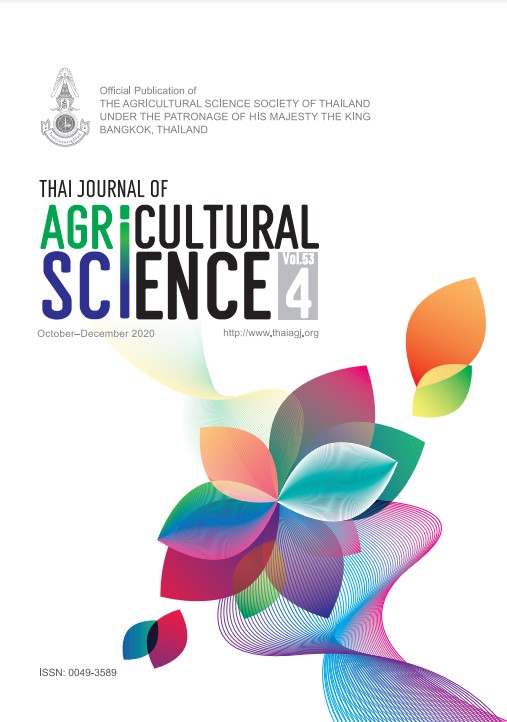Control of anthracnose in “Kluai Hom Tong” banana (Musa (AAA group)) using mangosteen pericarp crude extract
Main Article Content
Abstract
Anthracnose is a postharvest disease caused by the fungus Colletotrichum musae that results in major economic losses during transportation and storage of bananas. Mangosteen fruit has been widely used as traditional medicine and also as an antimicrobial agent against plant pathogenic fungi. The effectiveness of mangosteen pericarp crude extract on controlling anthracnose in “Kluai Hom Tong” banana (Musa (AAA group)) was evaluated. The fruits were dipped in various concentrations (0, 1,000, 1,200 and 1,400 mg L-1) of mangosteen pericarp methanol crude extract solution for 2 min and then sprayed with 1 mL of 106 spores mL-1 of Colletotrichum musae. Incubated fruits at 29 ± 2°C for 2 days and stored at 13 ± 2°C for 14 days. Banana fruits were further directly sprayed with 1 mL of 500 mg L-1 of ethephon solution and incubated for one day at room temperature. Anthracnose disease percentage and quality of banana fruits as total soluble solids (TSS), titratable acid (%TA), fresh weight and color were recorded. Color measurements were recorded 2 days interval. The results showed that mangosteen pericarp crude extract treatment demonstrated a lower disease percentage than non-treated fruits and the lowest disease percentage was found in the 1,200 mg L-1 treatment at 45% with 8 days of shelf life.
Article Details
References
Akao, Y., Y. Nakagawa, M. Iinuma and Y. Nozawa. 2008. Anti-cancer effects of xanthones from pericarps of mangosteen. Int. J. Mol. 9: 355–370.
Al-Massarani, S.M., A.A. El Gamal, N.M. Al-Musayeib, R.A. Mothana, O.A. Basudan, A.J. Al-Rehaily, M. Farag, M.H. Assaf, K.H. El Tahir and L. Maes. 2013. Phytochemical, antimicrobial and antiprotozoal evaluation of Garcinia mangostana pericarp and α-mangostin, its major xanthone derivative. Molecules 18: 10599–10608.
Anuchai, J., M. Chumthongwattana, R. Tepsorn and S. Supapavnich. 2018. Efficiency of salicylic acid immersion using fine-bubble technique on quality of Musa AAA fruit during ripening. IJAT. 14(7): 1003–1016.
AOAC (Association of Official Analytical Chemists). 1990. Official Methods of Analysis. 15 edition. Washington, D.C., USA.
Boun, H.R. and C.C. Huxsoll. 1991. Control of minimally processed carrot (Daucus carota) surface discoloration caused by abrasion peeling. J. Food Sci. 56: 416–418.
Chomnawang, M.T., S. Surassmo, V.S. Ukoolkarn and W. Gritsanapan. 2005. Antimicrobial effects of Thai medicinal plants against acne-inducing bacteria. J. Ethnopharmacol. 3(101): 330–333.
Cruz, M.E.S., K.R.F. Schwan-estrada, E. Clemente, A.T. Itako, J.R. Stangarlin and M.J.S. Cruz. 2013. Plant extracts for controlling the postharvest anthracnose of banana fruit. Rev. Bras. Plantas Med. 15(4) (Suppl. I): 727–733.
Gopalakrishnan, G., B. Banumathi and G. Suresh. 1997. Evaluation of the antifungal of natural xanthones from Garcinia mangostana and their synthetic derivatives. J. Nat. Prod. 60: 519–524.
Jeffries, P., J.C. Dodd, M.J. Jeger and R.A. Plumbley. 1990. The biology and control of Colletotrichum species on tropical fruit crops. J. Plant Pathol. 39: 343–366.
Ji, X., B. Avula and I.A. Khan. 2007. Quantitative and qualitative determination of six xanthones in Garcinia mangostana L. by LC-PDA and LC-ESI-MS. J. Pharm. Biomed. Anal. 43(4): 1270–1276.
Jung, H.A., B.N. Su, W.J. Keller and A.D. Kinghorn. 2006. Antioxidant Xanthones from the pericarp of Garcinia Mangostana (Mangosteen). J. Agric. Food Chem. 54: 2077–2082.
Kaka, A.K., K.A. Ibupoto, S.H. Chattha, S.A. Soomro, H. Mangio, S.A. Junejo, A.H. Soomro, S.G. Khaskheli and S.K. Kaka. 2019. Effect of hot water treatments and storage period on the quality attributes of banana (Musa sp.) fruit. Pure Appl. Biol. 8(1): 363–371.
Kitinoja, L. and A.A. Kader. 2015. Measuring Postharvest Losses of Fresh Fruits and Vegetables in Developing Countries. PEF White Paper 15–02. The Postharvest Education Foundation. Oregon, USA.
Kuyu, G.C. and Y.B. Tola. 2018. Assessment of banana fruit handling practices and associated fungal pathogens in Jimma town market, southwest Ethiopia. Food Sci. Nutr. 6(3): 609–616.
Matsumoto, K., Y. Akao, E. Kobayashi, K. Ohguchi, T. Ito, T. Tanaka, M. Iinuma and Y. Nozawa. 2003. Induction of apoptosis by xanthones from mangosteen in human leukemia cell lines. J. Nat. Prod. 66(8): 1124–1127.
Montri, N., K. Bunya-atichart and P. Leujantuak. 2010. Effect of crude extract from Stemona curtisii Hook.f. on anthracnose controlling in ‘Kluai Hom Tong’ Musa sp. (AAA group). Agri. Sci. J. 41(1)(Suppl.): 333–336.
Moosophin, K., T. Wetthaisong, L. Seeratchakot and W. Kokluecha. 2010. Tannin extraction from mangosteen peel for protein precipitation in wine. KKU Res. J. 15(5): 377–385.
National Committee on Agricultural Commodity and Food Standards. 2008. Available Source: http:// www.acfs.go.th/standard/download/eng/bananas.pdf.
OAE (Office of Agricultural Economics). 2012. Available Source: http://www.oae.go.th/.
Palakawong, C., P. Sophanodora, P. Toivonen and P. Delaquis. 2013. Optimized extraction and characterization of antimicrobial phenolic compounds from mangosteen (Garcinia mangostana L.) cultivation and processing waste. J. Sci. Food Agric. 93: 3792–3800.
Pedraza-Chaverri, J., N.C. Rodríguez, M.J. Orozco–Ibarra and M. Pérez-Rojas. 2008. Medicinal properties of mangosteen (Garcinia mangostana). Food Chem. Toxicol. 46: 3227–3239.
Ranasinghe, L.S., B. Jayawardena and K. Abeywickrama. 2003. Use of waste generated from cinnamon bark oil extraction as a postharvest treatment of Embul banana. J. Food Agric. Environ. 1(1): 340–344.
Saepudin, A., D. Natawijaya, E. Hartini and R. Iskandar. 2019. Evaluation of antibacterial activity of mangosteen (Garcinia mangostana L.) pericarp extract against rice leaf blight bacteria (Xanthomonas oryzae pv. oryzae) at various temperatures and durations of fruit storage. IOP Conference Series: Earth Environmental Science. 250: 012026.
Sagar, N.A., S. Pareek, S. Sharma, E.M. Yahia and M.G. Lobo. 2018. Fruit and vegetable waste: bioactive compounds, their extraction, and possible utilization. Compr. Rev. Food Sci. F. 17(3): 512–531.
Sangsuwan, J., S. Khamthai and P. Thongchai. 2011. Utilization of mangosteen pericarp powder for anti–anthracnose disease packaging material production in “Hom Thong” banana (Musa AAA group). Agri. Sci. J. 42(1) (Suppl.): 579–582.
Siripanich, J. and V. Luckanatinvong. 1997. Chemical composition and the development of flesh translucent disorder in mangosteen. In: Proceedings of the Australian Postharvest Holticulture Conference. Australia, Sydney.
Vishnu, P.V., M. Jainu, S.K. Mohan, P. Saraswathi and V.S.C. Gopan. 2010. Antimicrobial activity of pericarp extract of Garcinia mangostana Linn. Int. J. Pharm. Sci. Rev. Res. 1(8): 278–281.


